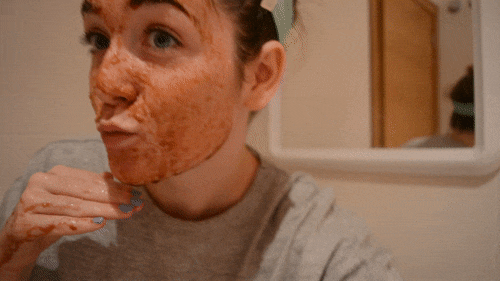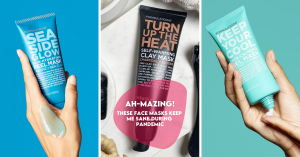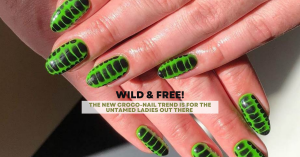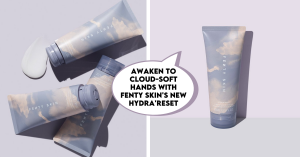Skin
Exfoliating 101: How To Properly Cleanse And Smoothen Out Your Skin
Let’s talk skin; it is the biggest organ on our body that protects us and our insides. However, this makes...
By: Beauty Insider Journalist / October 5, 2021

Let’s talk skin; it is the biggest organ on our body that protects us and our insides. However, this makes it susceptible to external harm and environmental damages such as pollution and UV rays. Therefore, grime, dead skin cells, oil and more contribute to creating a layer on our body that traps healthy skin. With that, Beauty Insider is writing this article to explain why exfoliating will provide you radiant, healthy skin!

Exfoliation is the act of eliminating dead skin cells from the surface of the skin to reveal younger, healthier cells beneath. Exfoliating your skin on a regular basis has several advantages, including lightening your skin tone and decreasing acne. Exfoliation, when done properly, may be included in anyone’s skincare routine, regardless of skin type.
Types Of Exfoliators
Physical
Physical exfoliation is the process of physically and manually exfoliating dead skin cells with a product such as a face scrub containing tiny, abrasive particles. These grains are massaged into the skin, buffing away the top layer of dead skin cells and other debris to reveal young, smooth skin.
Commonly used ingredients in physical exfoliators
Pumice crystals
Although most exfoliating agents are effective for all skin types, some skin types are more resistant to exfoliation and require a stronger exfoliant. Pumice crystals, another natural exfoliator, give manual microdermabrasion that removes dullness, fine wrinkles, and trouble pores. Furthermore, this exfoliating component is perfect for individuals who do not have sensitive skin and prefer a more aggressive physical exfoliation.
Jojoba beads
This gentle, non-abrasive exfoliator is commonly found in exfoliating treatments for sensitive skin, although it may be used on all skin types. Jojoba beads are polished, spherical, and smooth on a microscopic level. With that, this means they will never scratch the skin and will only use a gentle buffing technique to remove dead skin cells. Additionally, jojoba beads are so mild that you may use them to exfoliate your lips or other sensitive areas of your face- just keep them away from your eyes!
Chemical
Chemical exfoliants for the face remove dead skin cells by breaking the connections between skin cells, loosening the dead skin and making it easier to wash away. Don’t be put off by the phrase “chemical.”
Whereas physical exfoliation can be harsh- chemical exfoliants can be gentler. Chemical exfoliants work by breaking down the bonds that hold skin cells together. Dead skin cells adhering to your skin’s upper layers can break free and be washed away once these connections are dissolved. Therefore, this procedure reveals healthy skin under the surface and allows other skin care products to penetrate deeper into the skin layer.
Commonly used ingredients used in chemical exfoliators
Alpha Hydroxy Acid (AHA)
AHAs are commonly referred to as fruit acids since they are produced from sugar cane or other plant sources. Glycolic acid, which is produced from sugar cane and is the most often used form in skincare products, is one of the AHAs. Because of its capacity to improve natural moisturising elements inside the skin, AHAs are typically suggested for normal to dry, sun-damaged skin.
Beta Hydroxy Acid (BHA)
BHAs are organic carboxylic acids that act on the surface of the skin as well as deep into the pore. Because they’re oil-soluble, they’re best for normal to oily skin with bumps, blockages, blemishes, and enlarged pores. Salicylic acid, the most well-known form of BHA, is a fat-soluble acid that is beneficial for oily skin and improves its capacity to infiltrate pores.
Retinoids
Retinoids are a large class of vitamin A-derived chemicals. There are various types of topical and oral medications available, ranging from over-the-counter to prescription strength. Retinoic acid, on the other hand, is a stronger derivative with a greater percentage that is only available by prescription. Despite this, it’s a great exfoliator that also helps with elastin and collagen production.
Do’s And Don’ts Of Exfoliating

Do’s
Wear sunscreen
SPF should always be used, but it is especially necessary after exfoliation. After exfoliating, your skin will be more susceptible to the sun’s damaging UV rays for a few days.
Exfoliate at night
You’re revealing a new layer of skin when you exfoliate. As a result, your skin has become more fragile and sensitive. Your skin is more vulnerable to UV damage and free radicals if you exfoliate throughout the day. Exfoliating at night is safer since it reduces exposure and allows the skin to recover while you sleep.
Maintain your usual skincare routine
You’re losing a portion of your skin’s barrier when you buff away dead skin cells. This is what keeps it moist and healthy! Exfoliation, like SPF, should always be followed by your normal skincare routine, especially moisturiser. This will guarantee that your skin’s moisture barrier is restored and that it does not dry out.
Don’ts
Over exfoliating
It’s crucial not to over-exfoliate since you risk permanently damaging your skin’s barrier function, which protects it from the outside and keeps moisture in. This can cause dehydration, redness, and peeling on the skin, aggravating acne. Because you continually remove the top layer of skin before the new layer can heal, it might create discomfort. Don’t exfoliate more than once or twice a week, and don’t exfoliate every day.
Stop if irritation occurs
Stop exfoliating right away if your skin feels sensitive, stings, or turns red or flaky. With that, give your skin a week or so to recover before resuming exfoliation. However, make sure you do your homework to ensure you’re using the correct products and methods for your skin type.

















